Physical education
Physical education, also known as Phys Ed., PE and in some Commonwealth countries as physical training or PT,[1] is a class that pupils are required to take at school. It is taken during primary and secondary education and encourages psychomotor learning in a play or movement exploration setting to promote health.[2]
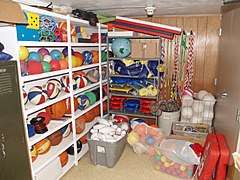
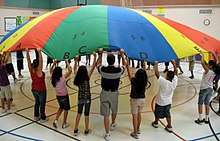
.jpg)
In addition, physical literacy is a 21st-century term that first emerged in the sport literature before also being applied to physical education. The concept of physical literacy covers a variety of conditions for a student.[3] Whether its motivation, confidence, physical competence, knowledge and understanding for student. Teachers implement these different concepts into their lesson plans to teach and develop students accordingly and appropriately for their individual success and education.
Whether the class produces positive effects on students' health, behavior, and academic performance depends upon the kind of program that is taught.[4] Physical Education programs vary all over the world. However, there are worldwide organizations that allow for a better understanding on how much exercise a child should be getting daily. Popular games in PE include football, netball, hockey, rounders, athletics and cricket.
Trends

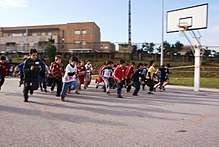
Physical education trends have developed recently to incorporate a greater variety of activities besides the skills necessary to play typical team sports such as football or basketball. Introducing students to activities like bowling, walking/hiking, or frisbee at an early age can help them develop good activity habits that will continue into adulthood.
Some teachers have begun to incorporate stress-reduction techniques such as yoga, deep breathing and tai chi. Tai chi, an ancient martial arts form focused on slow meditative movements, is a relaxation activity with many benefits. Studies have shown that it enhances muscular strength and endurance, as well as cardiovascular endurance. It also provides psychological benefits such as improving general mental health, concentration, awareness and positive mood.[5] It can be taught to any age student with little or no equipment, making it ideal for mixed ability and age classes. Tai chi can easily be incorporated into a holistic learning body and mind unit.[6]
Teaching non-traditional sports may also provide motivation for students to increase their activity, and can help them learn about different cultures. For example, while learning about lacrosse in the Southwestern United States, students might also learn about the Native American cultures of the Northeastern United States and Eastern Canada, where the sport originated. Teaching non-traditional (or non-native) sports provides an opportunity to integrate academic concepts from other subjects as well, which may now be required of many PE teachers. Non-traditional sports add benefits and challenges for those who often get easily distracted, are uncoordinated, or have less interest in traditional sports, which helps to make PE classes accessible to as wide a group of children as possible.[7]
PE is very important to students' health and overall well-being. The Centers for Disease Control and Prevention stated that over the past three years obesity in children (ages 2–5) and adolescents (ages 12–19) has doubled because of diet and lack of activity. Since the 1970s the number of children who are obese has tripled.[8]
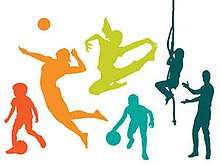
SHAPE America's National Standards & Grade-Level Outcomes for K-12 Physical Education define what a student should know and be able to do as result of an effective physical education program.[9]
Another trend is the incorporation of health and nutrition into the physical education curriculum. The Child Nutrition and WIC Reauthorization Act of 2004 required that all school districts with a federally-funded school meal program develop wellness policies that address nutrition and physical activity.[10] While teaching students sports and movement skills, PE teachers are now incorporating short health and nutrition lessons into the curriculum. This is more prevalent at the elementary school level, where students do not have a specific Health class. Recently most elementary schools have specific health classes for students as well as physical education class. Due to the recent outbreaks of diseases such as swine flu, school districts are making it mandatory for students to learn about practicing good hygiene along with other health topics. Children have a primary responsibility of attending school and providing evidence that they are achieving the content standards of their given grade level. If children engage in unhealthy behaviors like poor eating habits, obtaining an insufficient amount of sleep, or overindulging in screen time or other sedentary behaviors, they are less likely to experience developmentally appropriate learning.[11]
Today, many states require Physical Education teachers to be certified to teach Health courses. Many colleges and universities offer both Physical Education and Health as one certification. This push towards health education is beginning at the intermediate level, including lessons on bullying, self-esteem and stress and anger management.
Research has shown that there is a positive correlation between brain development and exercising.[12]
Incorporating local indigenous knowledge into physical education can lead to many meaningful experiences and a way of learning about other cultures. For example, by incorporating traditional knowledge from varying indigenous groups from across Canada, students can be exposed to many concepts such as holistic learning and the medicine wheel. A unit could be focused on connecting to a place or feeling while outdoors, participating in traditional games, or outdoor environmental education. These types of lesson can easily be integrated into other parts of the curriculum and give Aboriginal students a chance to incorporate their culture in the local school community.[13]
Studies have been done in how physical education can help improve academic achievement. In a 2007 article, researchers found a profound gain in English Arts standardized testing test scores among students who had 56 hours of physical education in a year, compared to those who had 28 hours of physical education a year.[14]
In Brazil, the physical education curriculum is designed to allow school pupils a full range of modern opportunities, including sports. Martial arts classes, like wrestling in the United States, and Pencak Silat in France, Indonesia, and Malaysia, teach children self-defense and to feel good about themselves. The physical education curriculum is designed to allow students to experience at least a minimum exposure to the following categories of activities: aquatics, conditioning activities, gymnastics, individual/dual sports, team sports, rhythms, and dance.
In these areas, a planned sequence of learning experiences is designed to support a progression of student development. This allows kids through 6th grade to be introduced to sports, fitness, and teamwork in order to be better prepared for the middle and high school age. In 1975, the United States House of Representatives voted to require school physical education classes include both genders.[15] Some high school and some middle school PE classes are single-sex.
Technology use in physical education
Old technology in education is playing a big role in classes. One of the most affordable and effective tools is a simple video recorder. With this, students can see the mistakes they're making in things such as a throwing motion or swinging form.[16] Studies show that students find this more effective than having someone try to explain what they are doing wrong, and then trying to correct it.[16] Educators may use technologies such as pedometers and heart rate monitors to make step and heart rate goals for students.[17]
Other technologies that can be used in a Physical Education setting include video projectors, GPS and games and gaming systems such as Kinect, Wii Fit and Dance Dance Revolution. Projectors can show students proper form or how to play certain games. GPS systems can be used to get students active in an outdoor setting, and active exergames can be used by teachers to show students a good way to stay fit in and out of the classroom setting.[18] Simulators are an efficient way to help promote being active in certain settings. Along with video projectors, GPS and game systems such as Kinect and Wii, simulators where the participant is using goggles to be out in a certain setting are beneficial. One method commonly used in the elderly that could benefit children would be a horse-riding simulator. This simulator allows the participant to be put into a country setting where they are free to roam multiple fields. This simulator is scientifically proven to help balance as well as stability. Relaxing the brain allows for better cognitive function leads to better test results in the classroom as well.[19]
Another type of technology that is commonly used in Physical Education is the pedometer. This does not necessarily track how far a person is going, but lets them know the number of steps they are taking.[20][21]
Around the world
Overview
All counties analyze physical activity in a certain way. According to the World Health Organization it is suggested that young children should be doing 60 minutes of exercise per day at least 3 times per week in order to maintain a healthy body.[22]
Asia
In Singapore, pupils from primary school through junior colleges are required to have two hours of PE every week, except during examination periods. Pupils may play games like football, badminton, captain ball, and basketball during most sessions. Unorthodox sports such as fencing, and skateboarding are occasionally played. In more prestigious secondary schools and in junior colleges, sports such as golf, tennis, shooting, and squash are played
An Biennial compulsory fitness exam, NAPFA, is conducted in every school to assess pupils' physical fitness in Singapore.[23] This includes a series of fitness tests (pull-ups/inclined pull-ups for girls, standing broad jump, sit-ups, sit-and-reach and 1.6 km for primary [10- to 12-year-olds]/2.4 km for secondary and junior college levels [13- to 18-year-olds]). Students are graded by gold, silver, or bronze, or as fail. NAPFA for pre-enlistees serves as an indicator for an additional two months in the country's compulsory national service if they attain bronze or fail.
In Malaysia, pupils from primary schools to secondary schools are expected to do two periods or one hour of PE throughout the year except a week before examinations. In most secondary schools, games like badminton, sepak takraw, football, netball, basketball and tennis are available. Pupils may bring their own sports equipment to the school with the authorization of the teacher .
In the Philippines, PE is mandatory for all years, unless the school gives the option for a student to do the Leaving Certificate Vocational Programme instead for fifth and sixth year. Some schools have integrated martial arts training into their physical education curriculum.[24][25][26][27][28]
In Indonesia, students ranging from kindergarten to high school have PE integrated with their curriculum. Kindergarten through grade 3 students have gymnastics. Starting from Grade 4, students are introduced to traditional martial arts Pencak Silat and some team games such as badminton, football, futsal, rounders, and basketball. Starting from junior high school, games such as basketball, volleyball, cricket, tennis, badminton, kho kho, and kabaddi are played. Drills and physical training are taught.
In Bhutan, the inclusion of Health and Physical Education in the school curriculum was formally endorsed during the 7th CAPSD Board Meeting in 1997. A series of pilot tests were conducted in primary schools from 1998 to 1999. Since the pilot tests were very successful, HPE was introduced as a formal teaching subject in all the primary schools from the year 2000.
In 2007, a set of revised curriculum books, consisting of a curriculum framework and eight activity books, were developed for use from 2009 academic session.
Australia
In Australia, physical education was first made an important part of the curriculum in government primary and secondary schools in 1981. The policy was outlined in a Ministerial Statement to the Victorian Legislative Assembly by the Minister for Educational Services, Norman Lacy MP on 17 September.[29]Many of the schools of Australia are moving to use the Praxis Model of Physical Education. Shane Pill of Flinders University in South Australia defines the Praxis model as a teaching method of Physical education that seeks to create a curriculum that promotes activities that teach the links between thinking, feeling, and behavior, and how positively affecting these aspects can increase the quality of life for Students. This model has been introduced with initiatives such as Healthy Active Australia Schools (HAAS) and Be Active-Let's Go. Rather than focusing on the traditional aspects of physical education, such as teaching how to perform a certain sport, this model focuses on a broader understanding of what it means to be educated in physical activity. The large goal of this initiative is to create a curriculum that makes an active difference in the pupils "lived reality now" so that students are making proactive changes to their behavior to increase overall health.[30]
Europe
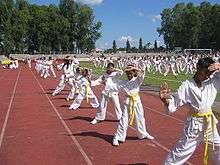
In Portugal, pupils from primary school can optionally join PE as an extra-curricular activity. From middle school to secondary school, pupils must participate in PE classes for two hours per week.
Scotland has a government supported requirement of a minimum of two hours of quality PE in primary and two periods (50 minutes each) in secondary S1 to S4. Recent funding has ensured most local authorities have employed PE lead officers to support the requirement. In fifth and sixth year, PE is voluntary in that personalisation and choice must be considered.
In England, pupils are expected to do two hours of PE a week in year 7, 8 and 9 and at least one in year 10 and 11.[31]
In Wales, pupils are expected to do two hours of PE a week.[32]
In Poland, pupils are expected to do at least three hours of PE a week during primary and secondary education.[33] Universities must also organise at least 60 hours of physical education classes at undergraduate courses.[34]
In Sweden, the time school students spend in PE lessons per week varies between municipalities but generally, year 0 to 2 has 55 minutes of PE a week, year 3 to 6 has 110 minutes a week and year 7 to 9 has 220 minutes. In upper secondary school, all national programs have an obligatory course, Idrott och hälsa 1, containing 100 points of PE, which corresponds to 90–100 hours of PE during the course. (One point should be one hour, but due to holidays this isn't true.) The schools can spend these hours as they like during the three years students attend. Most schools have students take part in this course during the first year and offer the follow-up course, Idrott och hälsa 2, which also contains 100 points.[35]
In Ireland, one is expected to do 2 classes worth of PE. (80 Minutes). This also includes shower and changing times, so on average 60–65 minutes outside.[36]
.jpg)
North America
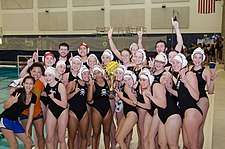
_Amy_Winczura_(5694030475).jpg)
In the United States, the goal of physical education is to "develop physically literate individuals who have the knowledge, skills and confidence to enjoy a lifetime of healthful physical activity."[37] The 2012 Shape Of The Nation Report by the National Association for Sport and Physical Education (part of SHAPE America) and the American Heart Association found that while nearly 75 percent of states require physical education in elementary through high school, over half of states permit students to substitute other activities for their required physical education credit, or otherwise fail to mandate a specific amount of instructional time. According to the report, only six states—Illinois, Hawaii, Massachusetts, Mississippi, New York and Vermont—require physical education at every grade level, from K-12.[38] A majority of states in 2016 did not require a specific amount of instructional time and more than half allow exemptions or substitution. These loopholes can lead to reduced effectiveness of the physical education requirements.[39] In North America, there are certain guidelines as to how much exercise a child needs per day to stay fit. The American Heart Association recommends that kids and teens (ages 6–17) get at least 60 minutes of moderate to vigorous physical activity every day.[40]
Zero Hour is a before-school physical education class first implemented by Naperville Central High School. In the state of Illinois this program is known as Learning Readiness PE. (LRPE). It was based on research indicating that students who are physically fit are more academically alert and experience growth in brain cells or enhancement in brain development. NCHS pairs a PE class that incorporates cardiovascular exercise, core strength training, cross lateral movements, and literacy and math strategies with literacy and math classes that utilize movement to enhance learning and improve achievement.[41]
In British Columbia, Canada, the government has stated in the grade one curriculum that students must participate in physical activity daily five times a week. The teacher is also responsible for planning Daily Physical Activity (DPA), which is thirty minutes of mild to moderate physical activity a day, not including curriculum physical education classes. The curriculum requires students in grade one to be knowledgeable about healthy living. For example, they must be able to describe benefits of regular exercise, identify healthy choices that require them to be more physically active, and describe the importance of choosing healthy food.[42]
Ontario, Canada has a similar procedure in place. On October 6, 2005 the Ontario Ministry of Education (OME) implemented a Daily Physical Activity policy in elementary schools, grades 1–8. It requires that all students in grades 1 to 8, including those with special needs, be provided with opportunities to participate in a minimum of twenty minutes of sustained moderate to vigorous physical activity each school day during instructional time.[43] There are many factors that contribute to the ease of implementing and sustaining a quality program, including the involvement of the administration, parents, and community. However, it ultimately comes down to the willingness of the physical education teacher(s) to do their best no matter the situation.[44]
References
- The Daily Telegraph, 25 July 2008: "Physical training in schools should be compulsory, says leading head" Linked 2014-04-09
- Anderson, D. (1989). The Discipline and the Profession. Foundations of Canadian Physical Education, Recreation, and Sports Studies. Dubuque, IA: Wm. C. Brown Publishers.
- Mitchell, Stephen (2016). The Essential of Teaching Physical Education. Shape America - Society of Health and Physical Educators. pp. 1 page cited (4 page). ISBN 978-1-4925-0916-5.
- Wong, Alia (2019-01-29). "Gym Class Is So Bad Kids Are Skipping School to Avoid It". The Atlantic. Retrieved 2019-01-30.
- "Tai Chi for Myoujusg need to be able to hold your breath for long while. ental Health | Psych Central News". Psych Central News. 24 May 2010.
- Lu C. (2007 )
- Lind, Treva. “Nontraditional Activities Benefit Kids Who Avoid Team Sports.” You Are Being Redirected..., Nov. 2017, www.athleticbusiness.com/recreation/nontraditional-activities-benefit-kids-who-avoid-team-sports.html.
- The Importance of Physical Education. (n.d.). Retrieved April 1, 2016, from http://www.veanea.org/home/1000.htm Archived 2017-10-23 at the Wayback Machine
- "National PE Standards-Highly Effective Physical Education".
- Pangrazi, Robert (2007) "Dynamic Physical Education for Elementary School Children" 15th ed.
- Castelli, Darla M., et al. “Vii. The History of Physical Activity and Academic Performance Research: Informing the Future.” Monographs of the Society for Research in Child Development, vol. 79, no. 4, Dec. 2014, pp. 119–148. EBSCOhost, doi:10.1111/mono.12133.
- REYNOLDS, GRETCHEN. "Phys Ed: Can Exercise Make Kids Smarter?". The New York Times. Retrieved 18 April 2013.
- Lowen, G
- Tremarche, Pamela V.; Robinson, Ellyn M.; Graham, Louise B. (2007). "Physical Education and Its Effect on Elementary Testing Results". Physical Educator. 64 (2): 58–64.
- "Physical Education – Jul 18, 1975 – NBC – TV news: Vanderbilt Television News Archive". Tvnews.vanderbilt.edu. 1975-07-18. Retrieved 2015-08-13.
- Wang, L., Myers, D., & Yanes, M. (2010). Creating student-centered learning experience through the assistance of high-end technology in physical education. Journal of Instructional Psychology, 37(4), 352–356.
- Woods, M., Karp, G., Goc, H., & Perlman, D. (2008). Physical educators' usage. Physical Educator, 65(2), 82–99
- Grimes, G. (2011, November 21). Interview by M Massey [Personal Interview].
- Kim, Seong-Gil; Lee, Jung-Ho (January 2015). "The effects of horse riding simulation exercise on muscle activation and limits of stability in the elderly". Archives of Gerontology and Geriatrics. 60 (1): 62–65. doi:10.1016/j.archger.2014.10.018. PMID 25465508.
- "Using pedometers to assess physical activity participation levels". Humankinetics.com. 2010-04-01. Retrieved 2015-08-13.
- "PEC: Pedometer Lesson Activities". Pecentral.org. Retrieved 2015-08-13.
- “Physical Activity and Young People.” World Health Organization, World Health Organization, 19 June 2015, www.who.int/dietphysicalactivity/factsheet_young_people/en/.
- "Napfa: From fitness test to education tool". AsiaOne. Retrieved 2018-10-19.
- Archived September 30, 2008, at the Wayback Machine
- Archived May 23, 2007, at the Wayback Machine
- "Regional Commissions and Chapters International Modern Arnis Federation Philippines Mindanao Commission". Imafp.com. Archived from the original on 2010-12-07. Retrieved 2010-11-07.
- Archived January 15, 2009, at the Wayback Machine
- "Sunday Inquirer Magazine: Life Lessons from Karate". Showbizandstyle.inquirer.net. 2008-12-14. Archived from the original on 2012-03-04. Retrieved 2010-11-07.
- Ministerial Statement on New Directions in Physical Education. Retrieved 2015-08-13.
- Pill, Shane. "Physical education — what's in a name? A Praxis model for holistic learning in physical education". ACHPER Healthy Lifestyles Journal. 54 (1): 5–10.
- "National curriculum in England: physical education programmes of study". GOV.UK. Department for Education. Retrieved 24 November 2016.
- "PE Provision in Secondary Schools" (PDF). Sports Council Wales. Retrieved 28 July 2016.
- "Dz.U. 2002 nr 15 poz. 142. Rozporządzenie Ministra Edukacji Narodowej i Sportu z dnia 12 lutego 2002 r. w sprawie ramowych planów nauczania w szkołach publicznych". Internetowy System Aktów Prawnych. Retrieved 31 October 2010.
- "Standardy kształcenia dla poszczególnych kierunków studiów i poziomów kształcenia". Biuletyn Informacj Publicznej. Archived from the original on 20 November 2010. Retrieved 31 October 2010.
- "Physical Education and Health" (PDF). Skolverket. Retrieved April 15, 2019.
- “Primary School Curriculum .” Curriculumonline, 1996, www.curriculumonline.ie/getmedia/ca8a385c-5455-42b6-9f1c-88390be91afc/PSEC05_Physical-Education_Curriculum.pdf.
- "Shape America Home Page". www.shapeamerica.org. Retrieved 2015-10-25.
- "Majority of States Have Loopholes That Let Kids Get Out of Gym Class". 2012-11-14.
- https://www.shapeamerica.org/uploads/pdfs/son/Shape-of-the-Nation-2016_web.pdf
- “How Can I Help My Child Be More Physically Active?” Www.heart.org, 17 Apr. 2018, www.heart.org/en/healthy-living/fitness/fitness-basics/aha-recs-for-physical-activity-in-children.
- Enhancing P.E. in Illinois, http://iphionline.org/pdf/P.E._Case_Study_Naperville.pdf
- BC curriculum package
- Archived December 12, 2006, at the Wayback Machine
- The Importance of Physical Education
External links
